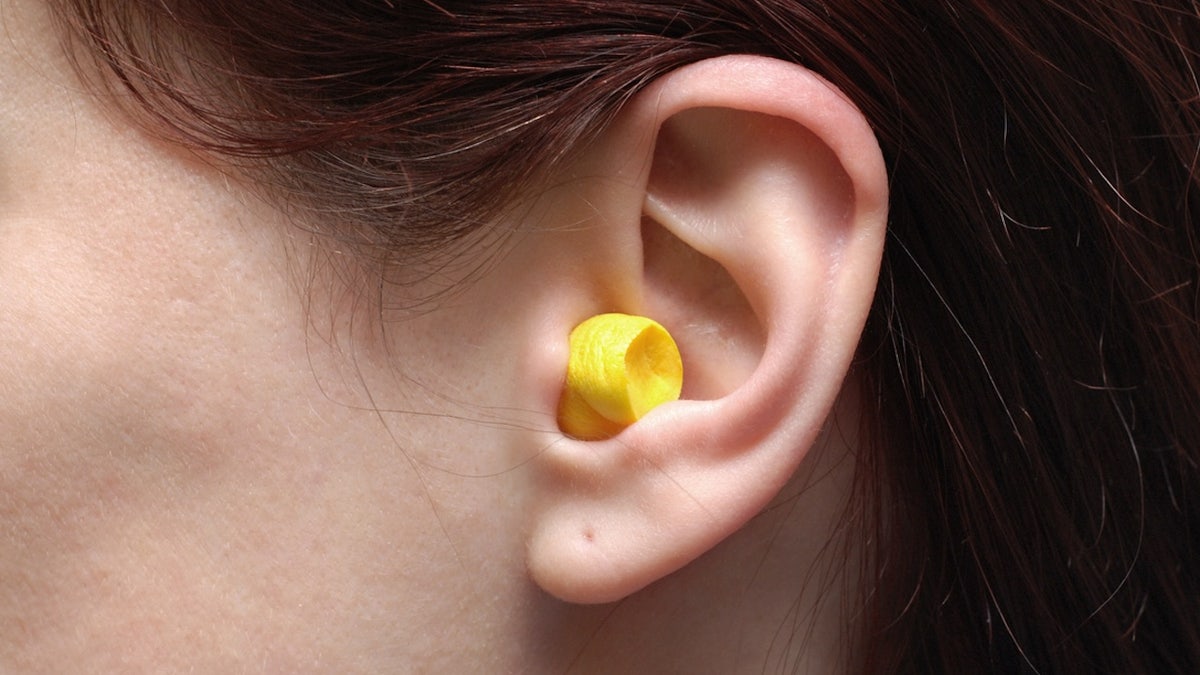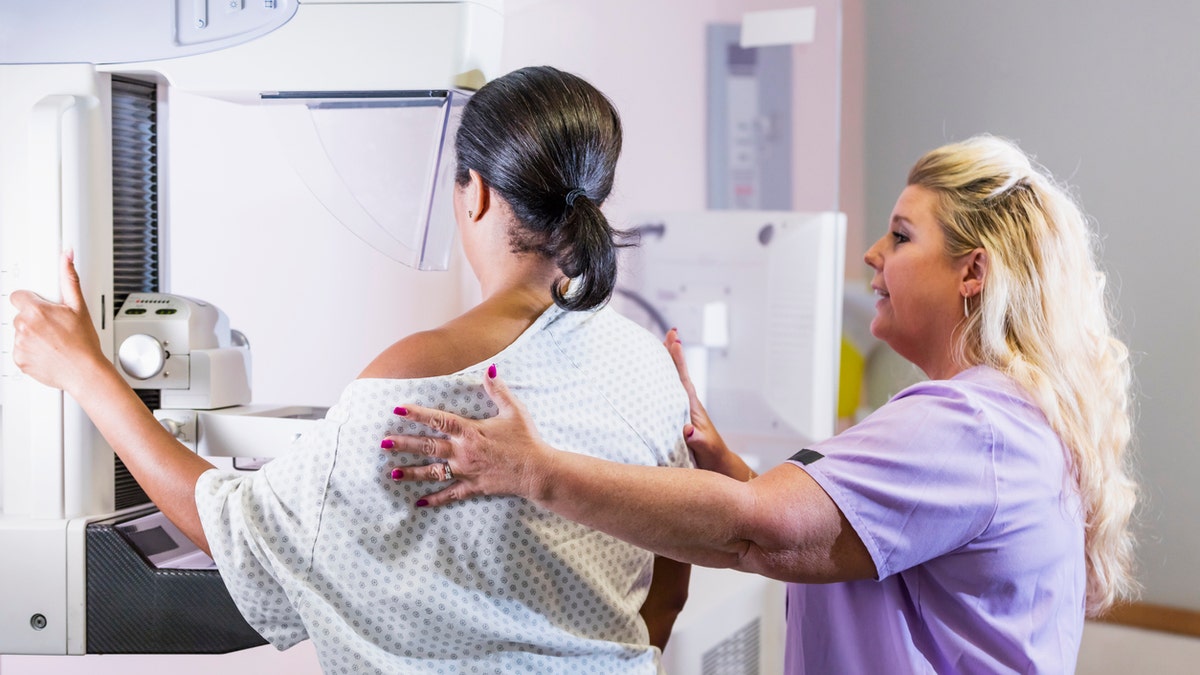Health
Fitness class too loud? What to know about protecting your hearing health

Your favorite cycling or dance class is a great way to burn calories and boost heart health — but it might not be so good for your ears.
Some audiology experts are warning that the loud volume of group fitness classes — from the blaring music to the instructor shouting directions — can take a toll on your hearing.
Workout classes often play music at over 85 to 90 decibels for an hour, which exceeds the recommended limits from the National Institute for Occupational Safety and Health (NIOSH), according to experts.
ASK A DOC: ‘WHY ARE MY EARS RINGING, AND SHOULD I SEE A DOCTOR?’
Here’s what to know.
What is a safe level of sound?
A safe sound level depends on the length of the class and the amount you are attending each week, according to Sabrina Lee, an audiologist at HearUSA in New York.
Some audiology experts are warning that the loud volume of group fitness classes can take a toll on your hearing. (iStock)
“Sounds at or below 70 decibels are considered safe for an extended period of time, meaning that if classes were constantly held at this sound level, you could do back to back classes or work as an instructor without any hearing concerns,” she told Fox News Digital.
Noise levels should not exceed 85 decibels over a one-hour period, says the World Health Organization, which is about the length of a fitness class.
“It’s safe to say that for a typical fitness class, a safe sound level is at or below 85 decibels,” Lee said.
EAR INFECTIONS IN YOUNG CHILDREN COULD LEAD TO DELAYED SPEECH FOR THEM, STUDY FINDS
Many classes exceed this level, the expert warned.
“High-intensity group fitness classes – like spinning, cardio or Zumba – can get up to and above 90 decibels, and sustain that volume throughout the class,” she said.
“The rationale for this is that many believe higher volumes of sound promote more intensity in workouts, and [it’s often] done as an encouragement to move to the beat.”

The World Health Organization recommends that noise levels should not exceed 85 decibels over a one-hour period. (iStock)
There is some science behind this, Lee acknowledged.
“Research does agree that music can help us engage well with a workout and can help motivate people to strive for intensity,” she said.
“For a typical fitness class, a safe sound level is at or below 85 decibels.”
“Aspects of music like a steady beat, motivational messaging and good, enjoyable sound are all things that can create a really dynamic and effective workout.”
This can pose a danger, however, as people crank up the volume to boost their motivation without realizing the possible negative side effects, Lee said.
Signs of adverse effects on hearing
There are some almost-instant signs that noise exposure may affect your hearing.
“If immediately after exposure, you notice that sounds are muffled to you, or you have ringing or buzzing sounds in your ears, you are likely having a temporary change in hearing as a result of noise exposure,” said Lee.

“High-intensity group fitness classes – like spinning, cardio or Zumba – can get up to and above 90 decibels, and sustain that volume throughout the class,” an expert said. (iStock)
These symptoms will usually fade away, but over time with repeated exposure to high intensities of sound, these effects may begin to take a permanent toll, she said.
The warning signs of permanent hearing loss may be a little different.
“If you find yourself getting confused or lost in group conversations, asking people to repeat themselves, or notice yourself regularly turning the volume up on headphones or speakers multiple times in order to hear, you might be experiencing the early stages of hearing loss,” Lee said.
ALL EARS FOR ‘SEXY’ HEARING AIDS: DESIGNERS TRANSFORM KEY DEVICES INTO COOL ACCESSORIES
Another sign of damage to hearing is experiencing ringing in your ears, known as tinnitus.
Anyone noticing these types of symptoms should see a hearing expert for an audiology test, experts recommend.
“This can diagnose where your hearing is currently and where it’s headed,” said Lee.
How studios are ensuring safe sound levels
While experts say there aren’t specific regulations for audio levels in fitness facilities, many of them have opted to put their own guidelines in place.
“Many classes now offer ear protection at the studio for attendees, indicating a movement toward more inclusive hearing health activities,” Lee said.

Anyone noticing symptoms of hearing loss should see a hearing expert for an audiology test, experts recommend. (iStock)
Orangetheory Fitness, a national chain of high-intensity interval training studios based on heart rate zones, incorporates music as an integral part of the experience.
Rory Ellis, the Florida-based vice president of innovation and design at Orangetheory, spoke with Fox News Digital about how the company ensures members’ hearing safety.
“OTF’s audio systems are meticulously installed and programmed to ensure that the maximum sound pressure levels do not exceed an average of 95 decibels during class, prioritizing safety without compromising on the intensity of the workout experience,” Ellis said.
DEAF GIRL FINALLY TELLS SANTA WHAT SHE WANTS FOR CHRISTMAS AFTER ELF HELPS HER ‘SIGN’ HER WISH LIST
“To achieve a consistent and controlled sound environment, we employ customized signal processing techniques, such as compression and limiting.”
One strategy that Orangetheory uses is microphone ducking technology, which helps ensure that the coach’s voice remains clear and intelligible.

“Research does agree that music can help us engage well with a workout and can help motivate people to strive for intensity,” an expert said. (iStock)
“This technology automatically lowers the music volume when the microphone is in use, maintaining the overall desired sound pressure level and eliminating the necessity or tendency to increase the microphone volume in an attempt to overpower the music,” Ellis said.
“The direct result is a safer, more immersive and exciting audio-visual workout experience for our clients, where the clarity of coaching is maintained without sacrificing the dynamic atmosphere of the class.”
Self-protective measures
If you find that the volume is too loud in a fitness class, there are several steps you can take.
Fitness class attendees and instructors should consider investing in a pair of comfortable hearing protection devices and wearing them when around the loud noise, recommended Brian Taylor, an audiologist and senior director of audiology at Signia Hearing in Minneapolis.

Earplugs can help maintain sound quality while reducing volume, an audiologist said. (iStock)
“So-called musician’s earplugs are a great choice for someone who is frequently exercising in a gym with loud music,” he told Fox News Digital.
“These earplugs maintain sound quality while reducing volume, making them ideal for individuals who frequent classes with loud music.”
“Length of exposure matters just as much as intensity of exposure.”
Lee noted that it may also be possible to change to a different location in the class to get farther away from the speakers — and if that fails, it’s best to step out of the class.”
She pointed out, “Length of exposure matters just as much as intensity of exposure … If noise levels are constantly too loud, even with hearing protection and while taking the above steps, it may also be worth considering looking into alternative fitness classes that refrain from playing loud music.”
BEST 50 ROCK SONGS FOR THE ULTIMATE WORKOUT PLAYLIST
Lauren Tritle, an Orangetheory fitness instructor in Cincinnati who also attends classes herself, told Fox News Digital that the coaches are more susceptible to hearing damage due to the number of classes they lead on a daily or weekly basis.
“As a member, I prefer the music louder so I don’t hear people talking or myself breathing heavily,” she told Fox News Digital.

Ringing in the ears, known as tinnitus, is one common sign of hearing loss. (iStock)
“However, paying more attention to the decibel meter would certainly assist in keeping everyone’s hearing safe,” Tritle said.
Tritle also uses the Noise app on her smartwatch, and it rarely registers unsafe levels during class.
CLICK HERE TO SIGN UP FOR OUR HEALTH NEWSLETTER
In her experience as an instructor, Tritle has seen some members use the earplugs provided by the studio, but she has never had a member complain about the volume being too loud.
Hearing loss can occur at any age, although some people are at a higher risk than others.

Sabrina Lee, an audiologist at HearUSA in New York, weighed in on the risks of high volumes at fitness studios. (Sabrina Lee)
“Even seemingly innocuous amounts of noise can have an accumulative effect that warrants the use of hearing protection,” said Taylor.
“As people age, their risk for hearing loss increases. If you are in doubt about your hearing sensitivity, get it checked out by a professional.”
Fox News Digital reached out to additional fitness studios requesting comment.
For more Health articles, visit www.foxnews.com/health.

Health
This Is Why You’re Not Losing Weight on Semaglutide + Doctors’ Tips To Speed Results

Sign Up
Create a free account to access exclusive content, play games, solve puzzles, test your pop-culture knowledge and receive special offers.
Already have an account? Login
Forgot your password?
Get back to the Sign In
Use left and right arrow keys to navigate between menu items.
Use escape to exit the menu.
Health
A mother's heartbreaking story, plus mammogram guidance and cancer-fighting nutrients

Derek McFadden, pictured at left with his mom Robin McFadden, was 23 when he took his own life on Aug, 17, 2018, in Tucson, Arizona. (Robin McFadden)
‘BROKE MY HEART’ – A New York mother said she believes chronic sleep deprivation contributed to her son’s suicide. She shares the heartbreaking story with Fox News Digital. Continue reading…
‘GREATER EMPATHY’ – Patients who see female physicians could live longer, a new study finds. Experts weigh in. Continue reading…
SCREENING OUT CANCER – Women should get mammograms every other year starting at age 40 instead of 50, according to updated recommendations from the U.S. Preventive Services Task Force. Here’s why. Continue reading…

The previous guidance stated women should begin biennial mammograms at age 50, but could opt to begin as young as 40. (iStock)
THE GOLD TREATMENT – An experimental “liquid gold” medication could bring new hope to multiple sclerosis patients, a study suggests. Continue reading…
CANCER BY THE NUMBERS – A new report reveals the latest trends in cancer diagnoses and deaths. See the top 5 observations. Continue reading…
SECRET WEAPON? – A common nutrient could help to boost cancer immunity, a new study suggests. Experts share the potential benefits. Continue reading…

Dietary vitamin D, found in foods including salmon, increased levels of the bacterium Bacteroides fragilis, which has been shown to improve cancer immune response. (iStock)
STROKE STOPPERS – A physical medicine and rehabilitation specialist shares specific tips for women to reduce their stroke risk. Continue reading…
‘THE SANDWICH GENERATION’ – Serving as a caregiver for a parent with dementia while also caring for kids can come with physical, mental and emotional challenges, experts say. Continue reading…
PEARLY WHITES – Dental experts share 7 tips to keep teeth bright, white and healthy. Continue reading…

Patients should visit the dentist for a general check-up every six months, experts recommended. (iStock)
FOLLOW FOX NEWS ON SOCIAL MEDIA
YouTube
SIGN UP FOR OUR NEWSLETTERS
Fox News First
Fox News Opinion
Fox News Lifestyle
Fox News Health
Fox News Autos
Fox News Entertainment (FOX411)
DOWNLOAD OUR APPS
Fox News
Fox Business
Fox Weather
Fox Sports
Tubi
WATCH FOX NEWS ONLINE
Fox News Go
STREAM FOX NATION
Fox Natio
Health
‘Liquid gold’ could bring new hope to multiple sclerosis patients, study suggests: ‘Profound benefit’

Researchers may have hit “gold” when it comes to the treatment of multiple sclerosis.
An experimental medication called CNM-Au8 — a drinkable liquid with gold nanocrystals — has shown promising results in clinical trials in terms of improvements in MS symptoms.
The “catalytically active” liquid, developed by Clene Nanomedicine in North East, Maryland, can cross the blood-brain barrier to help improve cellular energy and restore neurological function, according to researchers.
BREAKTHROUGH FOR MULTIPLE SCLEROSIS SUFFERERS MAY INVOLVE HELPFUL HORMONE: ‘PATIENTS SHOULD REMAIN OPTIMISTIC’
Doctors at the University of Sydney presented the Phase 2 clinical trial findings at the American Academy of Neurology’s annual meeting earlier in April 2024.
The clinical trials included 78 patients who had relapsing multiple sclerosis.
An experimental medication called CNM-Au8 — a drinkable liquid with gold nanocrystals — has shown promising results in clinical trials for improving MS symptoms. (Clene Nanomedicine)
The gold liquid suspension was found to have a “profound clinical benefit,” with the patients experiencing physical improvements not achieved in prior trials.
A need for new MS drugs
Multiple sclerosis is an autoimmune disease of the central nervous system, brain, spinal cord and optic nerve.
In people with MS, white cells called lymphocytes infiltrate the central nervous system and trigger inflammation.
That often causes them to feel off balance or lose their vision, according to Dr. Robert C. Sergott, chief of the neuro-ophthalmology service at Wills Eye Hospital and professor of ophthalmology, neurology and neurosurgery at Sidney Kimmel Medical College in Philadelphia.
The MS medications that are currently available work by addressing inflammation — but there is a subset of patients that continue to experience symptoms even without inflammation, he said. This is a condition called progression independent of relapse activity (PIRA).
RESEARCHERS FIND SOURCES OF FOUR BRAIN DISORDERS, WHICH COULD LEAD TO NEW TREATMENTS
“This is a non-inflammatory component of the disease, where patients would worsen in vision and cognitive abilities,” Sergott, who was involved in the clinical trial for CNM-Au8, told Fox News Digital.
Researchers suspected that something to do with mitochondria — parts of cells that are responsible for supplying those cells with energy — was causing these patients’ symptoms.
“The theory was that if we could give the mitochondria an extra boost, the neurons, axons and other cells in the central nervous system may work better,” said Sergott.

The “catalytically active” liquid can cross the blood-brain barrier to help improve cellular energy and restore neurological function, according to researchers. (Clene Nanomedicine)
“In other words, maybe these cells aren’t dead, but they’re hibernating.”
Gold nanoparticles were originally used to treat rheumatoid arthritis many years ago, according to Sergott.
“Clene innovated a novel electrochemical method to make gold particles and [got] them to a very highly purified nanoparticle state — into very small particles, so they can get through the blood-brain barrier to the cells that need it to work better.”
‘Significant result’
Among the 78 participants in the randomized clinical trial performed in Australia, two-thirds of them received the gold treatment and the other third received a placebo over a three-year period.
“We had hoped to enroll more patients, but COVID intervened,” Sergott said.
Neither the patients nor the neurologist overseeing the trial knew who was receiving the actual medicine.
“We’re very encouraged and ready to take the next step. It’s going to help a lot of people.”
“Patients saw a clinical improvement in the function of their vision and their cognitive ability,” Sergott reported.
Doctors also noted an improvement in the electrophysiology, he said — “the patients’ MRIs looked better, which is a special measure.”

“The theory was that if we could give the mitochondria an extra boost, the neurons, axons and other cells in the central nervous system may work better,” a doctor said. (iStock)
The patients who received the medicine had no decline in retinal thickness, but those on the placebo did see a decline, he said.
“This was a very significant result, and gives us a lot of hope that we may be able to help patients who have deficits from MS and have had progression independent of relapse activity — or maybe they had an attack and didn’t get complete recovery from it,” Sergott said.
TO LIVE LONGER, DO THESE 5 THINGS EVERY DAY, SAYS A BRAIN HEALTH EXPERT
None of the trial participants reported any adverse side effects, he said.
“The safety profile is excellent,” Sergott told Fox News Digital. “I can’t say this doesn’t have any side effects — but no patients discontinued the trial because of a side effect that was significant.”

None of the trial participants reported any adverse side effects from the gold treatment, the researchers said. (iStock)
With the successful Phase 2 trials complete, researchers are now looking ahead to Phase 3 trials.
“We’re very encouraged and we’re ready to take the next step,” said Sergott. “It’s really going to help a lot of people.”
Patients taking CNM-Au8 would still need to continue with the standard regimen of anti-inflammatory medications, the doctor noted.
CAN WE REVERSE ALZHEIMER’S DISEASE? EXPERTS SUGGEST ‘NEW PARADIGM’ FOR COMBATING DEMENTIA
Looking ahead, there is the potential for the “liquid gold” medication to help treat symptoms of other neurological disorders, including amyotrophic lateral sclerosis (ALS), Alzheimer’s and Parkinson’s, according to Sergott — but the focus is on MS for now.
“We don’t want to get too far ahead of ourselves, but there is plenty of information to support trying this in other diseases.”
Patient shares his experience
Damian Kunko of Arlington, Virginia, was one of the MS patients who participated in the trial. He had previously taken disease-modifying therapies that included Zeposia and Tecfidera.
“These drugs reduced the risk of relapse, but had no effect on progressive symptom worsening,” Kunko told Fox News Digital.

Damian Kunko of Arlington, Virginia, was one of the MS patients who participated in the trial. (Clene Nanomedicine)
Kunko’s primary symptoms included heat intolerance, foot drop/limping, numbness, balance issues, double vision and minor decline of cognitive function and energy.
After four months of taking CNM-Au8, Kunko found that his walking speed was 14% faster.
“I was also able to do short 5-10-yard jogs without falling, which was impossible prior to taking [the drug],” he said.
“The best ‘side effect’ was knowing that this drug will fix my MS issues.”
“I also experienced improved visual acuity, less severe double vision, zero cognitive fog issues and increased energy levels.”
Later in the trial, Kunko was able to withstand high heat and humidity for several hours and did not experience any double vision, foot drop, excessive numbness or fatigue issues.
“It was nice to be able to go up and down stairs without having to hold the railing,” he said.

Clinical improvements were seen in both the visual system and on patients’ MRI scans, according to doctors. (iStock)
The patient said he did not experience any negative side effects or adverse reactions.
“The best ‘side effect’ was knowing that this drug will fix my MS issues,” Kunko said.
“I am very disappointed that this therapy is not yet commercially available for those who need to restore function and alleviate MS symptoms,” he added.
Doctors weigh in
Dr. Marc Siegel, clinical professor of medicine at NYU Langone Medical Center and a Fox News medical contributor, was not involved in the drug’s development but commented on the potential of gold therapies.
“Gold-containing analogies have long been treatments for rheumatoid arthritis — what is known as disease-modifying anti-rheumatic drugs,” he told Fox News Digital.
“And now gold-containing agents are being studied in MS and ALS.”
While the latest study is small, Siegel said, it “looks promising in terms of modifying disease and improving thinking and vision, which can be affected in the early stages of MS.”
He added, “More research with larger numbers needs to be done to be conclusive.”

“Gold-containing analogies have long been treatments for rheumatoid arthritis — what is known as disease-modifying anti-rheumatic drugs,” one doctor told Fox News Digital. (Clene Nanomedicine)
Dr. James Kuo, vice president of R&D at Silo Pharma in New Jersey, was also not involved in the drug’s development but said the trial results are “encouraging.”
“These new long-term results from the Phase 2 clinical trial support the therapeutic hypothesis that CNM-Au8 is remyelinating nerve cells in MS patients,” Kuo told Fox News Digital.
CLICK HERE TO SIGN UP FOR OUR HEALTH NEWSLETTER
“What is further encouraging is that both the primary and secondary endpoints showed continued improvement,” he added. “There was physiological enhancement in the visual neural pathway, a biomarker of nerve health. Further MRI measurements support remyelination occurring.”
“If further clinical data supports these initial findings, MS patients could well have a new, well-tolerated oral therapy that is not based upon immune system modulation.”

Ensuring proper dosing, monitoring patients for potential side effects and following proper follow-up protocols are “essential aspects” of bringing this therapy into clinical practice, a doctor said. (iStock)
Dr. Sameea Husain Wilson, director of movement disorder neurology at Marcus Neuroscience Institute, at Boca Raton Regional Hospital in Florida, said that CNM-Au8 offers hope for patients and their families.
“It shows promise in the possibility of slowing disease progression, improving symptoms and enhancing quality of life,” he told Fox News Digital in a statement.
Wilson noted, however, that it is important to “approach the drug development cautiously and be aware of potential risks.”
“The complexity of neurodegenerative diseases necessitates a comprehensive understanding of individual patient profiles,” he said.
“It’s essential to recognize that not all patients may respond uniformly to treatment, and factors such as disease stage, comorbidities and genetic predispositions may influence outcomes.”
Ensuring proper dosing, monitoring patients for potential side effects and following proper follow-up protocols are “essential aspects” of bringing this therapy into clinical practice, Wilson added.
For more Health articles, visit www.foxnews.com/health.
-

 Education1 week ago
Education1 week agoVideo: Dozens of Yale Students Arrested as Campus Protests Spread
-

 World6 days ago
World6 days agoHaiti Prime Minister Ariel Henry resigns, transitional council takes power
-

 News1 week ago
News1 week agoLarry Webb’s deathbed confession solves 2000 cold case murder of Susan and Natasha Carter, 10, whose remains were found hours after he died
-

 Politics1 week ago
Politics1 week agoFetterman hammers 'a–hole' anti-Israel protesters, slams own party for response to Iranian attack: 'Crazy'
-

 World1 week ago
World1 week agoPeriod poverty still a problem within the EU despite tax breaks
-

 World1 week ago
World1 week agoUS secretly sent long-range ATACMS weapons to Ukraine
-

 News6 days ago
News6 days agoFirst cargo ship passes through new channel since Baltimore bridge collapse
-

 World1 week ago
World1 week agoTurkey’s Erdogan meets Iraq PM for talks on water, security and trade














